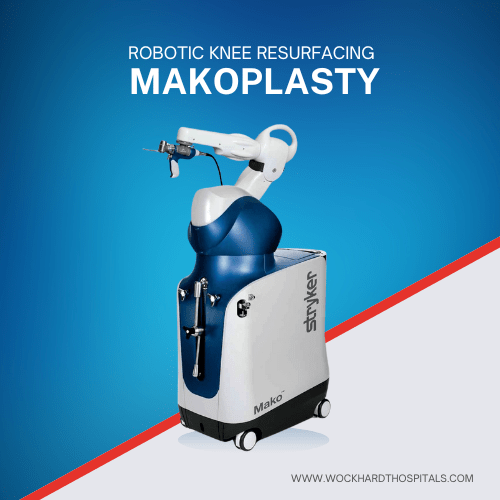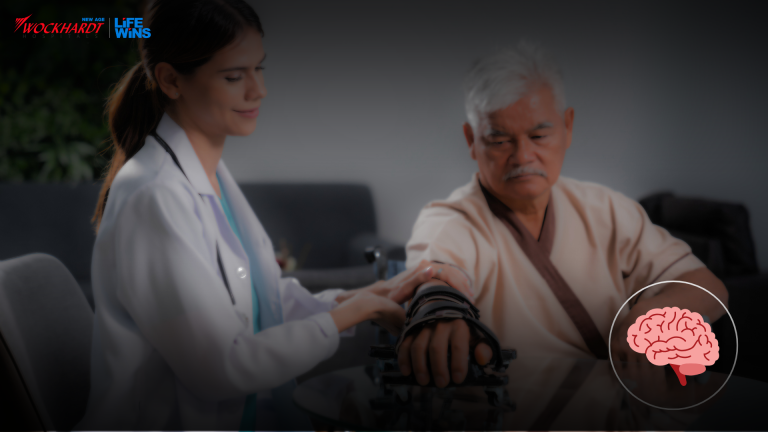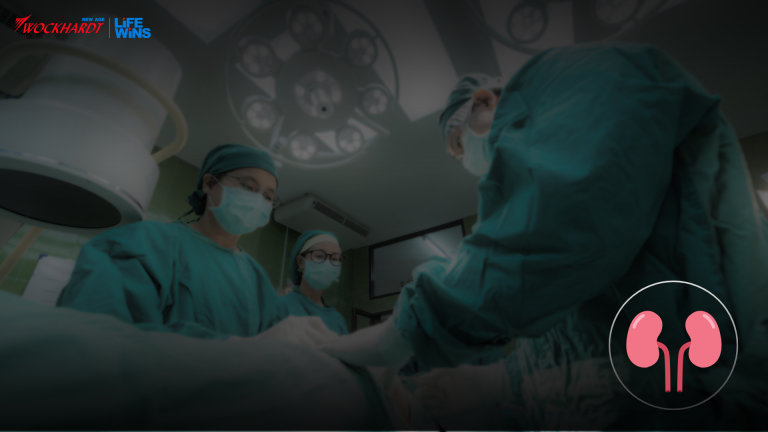Makoplasty : Robotic Knee Resurfacing

Dr. Mudit Khanna at Wockhardt Hospitals, Mumbai Central has pioneered the use of Mako SmartRobotics in South Mumbai to treat arthritis of the Knee. He is the first surgeon in the region to perform Makoplasty Robotic Knee Resurfacing and has now gained significant experience with this technique. Makoplasty: An Alternative to Total Knee Replacement Makoplasty Robotic knee resurfacing can be an attractive alternative to total knee replacement in the appropriate patient. This technique, which involves robotic bone contouring of arthritic surfaces and customized resurfacing of the damaged area, represents an improvement over traditional or conventional partial (or unicondylar) knee replacement. Without robotic assistance, partial knee replacement can provide excellent and durable pain relief but is technically challenging, and carries a higher potential for surgical inaccuracy. Dr Mudit Khanna’s experience, combined with Mako SmartRobotic safeguards, provide an unparalleled level of accuracy, precision and personalization to optimize patient outcomes. Advantages of Robotic Assistance in Knee Resurfacing After robotic knee resurfacing, Dr. Khanna expects patients to return to work much faster. Compared to total knee replacement, robotic knee resurfacing provides more reliable return to select sports, a quicker and less painful recovery, a smaller incision, a more natural feeling knee, and, importantly, a lower risk of complications. Dr. Khanna performs all his Makoplasty knee resurfacing procedures at the SOBO Unit of Wockhardt Hospitals which carries one of the lowest infection rates in the region. Comprehensive Pain Management and Rehabilitation Realizing the significance of Early rehabilitation and importance of Post-operative Pain management, Dr. Mudit Khanna with the help of the department of Anesthesia has established an excellent Enhanced Recovery After Surgery (ERAS) Program at Wockhardt Hospitals, which helps to achieve Rapid recovery after Joint Replacement Surgery by improving the quality of perioperative care with special focus on achieving excellent pain management through a multimodal pain management protocol. In addition to Dr. Mudit Khanna’s expertise, the world-class environment at Wockhardt enhances the patient experience and outcome. Schedule your consultation with Dr. Mudit Khanna today and take the first step towards a pain-free, active life with Makoplasty Robotic Knee Resurfacing!
Rediscovering Life: A Parkinson’s Journey from Neglect to Hope

Parkinson’s disease (PD), the second most common neurodegenerative disorder after Alzheimer’s, is often misinterpreted as a natural part of aging. Affecting nearly 1% of individuals over 60, PD frequently goes undiagnosed in its early stages, leading to unnecessary suffering. Dr. Manish Baldia, Functional Neurosurgeon at Wockhardt Hospitals, Mumbai, sheds light on the critical need for early detection and intervention. A retired school principal in his early 70s, exemplifies the challenges of misdiagnosed Parkinson’s disease. For years, he attributed his tremors, slowed movements, and fatigue to aging. His family, though concerned, also dismissed the symptoms as part of the natural aging process. This misconception led to a decline in his quality of life, causing emotional distress and social withdrawal. The turning point came when a visiting relative, a medical professional, urged him to seek specialized care. A neurologist confirmed the diagnosis of Parkinson’s disease, bringing both relief and apprehension. With timely intervention, He was introduced to advanced treatments, including Deep Brain Stimulation (DBS), medication adjustments, and rehabilitation therapy under the expertise of Dr. Baldia. After undergoing DBS, a cutting-edge procedure that regulates abnormal brain activity through electrical impulses, He experienced a dramatic improvement in his motor functions. His tremors reduced, his voice regained strength through speech therapy, and he even resumed hobbies like gardening—activities he once believed were lost forever. A Message of Hope and Awareness Now thriving with his condition, He has become an advocate for Parkinson’s awareness, urging others to recognize early symptoms and seek timely medical attention. “The biggest lesson I’ve learned is not to ignore your body’s signals. Growing older doesn’t mean suffering in silence. Parkinson’s is not the end—it’s a new beginning with the right guidance,” he passionately shares. Dr. Manish Baldia emphasizes, “Early diagnosis and access to advanced treatments can dramatically improve the quality of life for Parkinson’s patients. Our goal is to ensure that no one else has to endure years of unnecessary suffering due to a lack of awareness.” He adds, “With advancements like Deep Brain Stimulation and personalized treatment plans, we can offer hope and a renewed quality of life to those battling Parkinson’s.” Wockhardt Hospitals remains at the forefront of neurological advancements, offering state-of-the-art treatments and compassionate care for Parkinson’s patients. As awareness grows, more individuals can regain control over their lives. _______ Dr. Manish Baldia, Functional Neurosurgeon at Wockhardt Hospitals, Mumbai Central, Shares Insights on “A Parkinson’s Journey from Neglect to Hope” – Exclusive Interview on Zee 24 Taas
Pelvic Floor Physical Therapy: Unlocking the Power Of Pelvic Floor

I am sure you all must have heard of urinary incontinence: often known as “THE MIDLAUGH CRISIS”. But have you ever thought beyond incontinence??? I used to think pelvic floor rehabilitation was only contained to urinary incontinence and post-pregnancy. I dug deeper into research and found out that 21% of women suffer from pelvic floor issues, training our pelvic muscles could lead to benefits that all age groups should know. It is not just limited to the elderly or pregnant but a lot more than that. Well, let me throw you some highlights on pelvic floor muscles first – They are a group of muscles that form a sling-like hammock that forms the base of your pelvis, supporting your bladder, bowel and reproductive organs Functions of the pelvic floor 1. Support: It supports our pelvic organs including our bowel and bladder. 2. Control: It helps you to control your bladder and bowel functions. 3. Sexual function: helps in sexual pleasure and satisfaction. 4. Core stability: Work with core muscles to stabilise your pelvic and spine. What are the common issues affecting the pelvic muscles? 1. Surgery 2. During pregnancy and after childbirth 3. Age related condition 4. Chronic conditions 5. Poor posture 6. Pelvic floor dysfunction The questions that often arise are, ‘Is pelvic floor rehab right for me?’ ‘What should I expect during the treatment?’ and’ Are there any side effects or risks?’ When to seek professional help? If you experience any of the symptoms, you need to consult a healthcare professional. A pelvic floor rehab therapist makes a detailed assessment and plans your treatment accordingly. They will then guide you in strengthening your pelvic floor muscles through various exercises and techniques to maintain your pelvic health. Here are some of the tips for maintaining healthy pelvic floor muscles: 1. Kegel exercises 2. Maintain a healthy weight 3. Practice good posture 4. Avoid straining 5. Stay hydrated 6. Limit caffeine and alcohol 7. Quit smoking 8. Engage in regular physical activity In addition to these lifestyle changes, it is very important to maintain good bladder habits 1. Emptying your bladder completely 2. Avoiding holding urine for too long 3. Urinating when you feel the urge “Remember, you are not alone in this. Many people experience pelvic floor dysfunction and with the right approach, significant improvements are achievable. Pelvic floor rehabilitation not only helps you to take control of your health but also incorporates simple exercises and lifestyle changes that can improve your quality of life. Don’t wait any longer – prioritize your pelvic health and start feeling better”
Pregnancy After 35: What You Need to Know About High-Risk Pregnancies?

Introduction Pregnancy is said to be high risk when it is often complicated by medical conditions that pose a threat to the well-being of the mother and the child. The risk associated with pregnancy is greater for anyone who is younger than 20 or older than 35. Several factors make a pregnancy high-risk, like age, lifestyle, general health, and genetics. This article provides essential information about managing a high-risk pregnancy after the age of 35. Understanding the Risks Before deciding to get pregnant after 35 years, it is crucial to understand all the risks that come with it. This is essential to prevent complications and be prepared. Some issues you might face are as follows: 1. It is more difficult to conceive: Every woman is born with a finite number of eggs, which keep decreasing throughout her life. From the mid to late thirties, the quality and quantity of your eggs start decreasing significantly, making it more difficult for them to be fertilized. 2. Higher chances of multiple pregnancies: Because of the hormonal changes happening at this age, there is a higher chance of releasing more than one egg in a single cycle, ultimately resulting in a multiple pregnancy. Also, since a good number of late pregnancies happen by artificial techniques, there is a higher incidence of twin pregnancies. 3. More chance of developing gestational diabetes: Gestational diabetes occurs only at the time of pregnancy. The risk of this type of diabetes is higher in older women. Gestational diabetes increases the likelihood of conceiving a child that may grow abnormally or be delivered prematurely. Hence, it is very important to follow a proper diet and take medications to treat gestational diabetes. 4. Higher risk of a premature birth: With older age, the chances of delivering an underweight baby increase as well. Premature babies are often more prone to complications. 5. Decreased possibility of vaginal birth: With all the impending complications, a C-section is often the recommended mode of delivery in such cases. 6. High risk of miscarriage: The risk of miscarriage and stillbirth directly increases with advanced age. This could be due to compromised egg quantity or other pre-existing medical ailments. 7. Increased possibility of chromosomal disorders. With an elderly mother, there is a significant increase in the chance of the baby developing any chromosomal aberrations like Down’s Syndrome. Precautionary Measures If you wish to plan for a pregnancy after 35, make sure to take proper measures to prevent complications. Here are some things you can do: 1. Take preconception vitamins: Start planning visits to your doctor right when you start planning your pregnancy. Getting regular preconception vitamins goes a long way in preventing any congenital abnormalities in the child. 2. Stay consistent with your check-ups: Make sure that you get all your scheduled tests and attend all your appointments. Monitoring the growth of the fetus is extremely important in a high-risk pregnancy. Identifying any problem as early as possible can help avoid complications. Make sure you are vaccinated when needed. 3. Eat healthy: As said earlier, gestational diabetes and general health concerns play a major role in complicating the high-risk pregnancy further. Eating a well-planned diet with good nutrition is very important to stay clear of such complications. 4. Prenatal testing: Currently, there are several options to check for chromosomal aberrations in the fetus. Enquire about such tests and do them if necessary. Recent advances in radio-diagnosis can also help determine very minute discrepancies in the fetus. Important Signs to Look For: Your healthcare professional will clearly explain when you will have to visit the hospital, and the signs considered an emergency. Here are a few signs of complications in high-risk pregnancies: Vaginal bleeding or abnormal discharge Abdominal pain Decreased fetal movements Severe headaches Disturbances in vision Sudden swelling in the face, fingers, and hand Fever or chills Severe vomiting The Well-Being of the Mother At Wockhardt Hospitals Mira Road, we ensure that all expectant mothers get enough reassurance and care from the treating physicians. We have dedicated a good amount of our time to researching how we can deliver the best possible care to expectant mothers, and ensure they embark on their journey to motherhood stress-free. By effectively implementing this principle in our healthcare services, so we have consequently observed a significant improvement in the overall success and outcomes of high-risk pregnancies over time. By reducing stress and preventing complications associated with a high-risk pregnancy, we have helped several women above 35 years of age conceive. Frequently Asked Questions (FAQs): Q1. What genetic tests can I get done? The commonly done tests include amniocentesis and chorionic villi sampling (CVS). Amniocentesis studies the fluid that surrounds the fetus in the uterus, usually after fifteen weeks of pregnancy. Amniocentesis can detect genetic conditions and defects in the brain or spinal cord.CVS studies the sample of cells from the placenta, usually done between the 1 0th and 13th week of pregnancy. Q2. What are the risky substances I should avoid when trying to conceive? Any form of tobacco, like e-cigarettes, poses a significant threat. Steer clear of alcohol and any kind of illegal substances. Make sure to consult with your doctor about any regular medications that you may be taking, as certain medicines and supplements may be harmful to the pregnancy. Q3. What are the general health problems that can complicate a high-risk pregnancy? Common medical conditions that tend to increase the risk associated with pregnancy are hypertension, obesity, diabetes, epilepsy, thyroid issues, heart defects, blood disorders, asthma, and other infections. Getting them checked before planning your pregnancy can significantly decrease the chance of developing complications later.
Sleep Apnea Treatment: Can ENT Surgeries Help You Sleep Better?

Sleep apnea is a sleep disorder that causes repeated interruptions in breathing during sleep, leading to disrupted rest and potential health issues. Your airway becomes partially or entirely obstructed as you sleep, leading to breathing problems. You may wake up just to continue breathing because of a survival response brought on by a consequent oxygen shortage. This can prevent complications but also disrupts your sleep pattern. Many people suffer from this condition, not knowing that they may improve their breathing and quality of sleep with the use of specialised therapies. The following article will explain the function of ENT surgeries and how ENT surgeons in Mumbai may help if you’re looking for effective sleep apnea treatment in Mira Road. Types of Sleep Apnea This potentially dangerous sleep condition causes breathing to stop and start again. Sleep apnea may cause loud snoring and fatigue even after a whole night’s sleep. These are the primary types of sleep apnea: ● Obstructive Sleep Apnea (OSA): This is the most common form. Here, the throat muscles relax excessively and block the airway. ● Central Sleep Apnea: The brain’s inability to properly communicate with the breathing muscles is the cause of central sleep apnea. ● Treatment-Emergent Central Sleep Apnea: Treatment-emergent central sleep apnea, also known as complex sleep apnea, occurs when a person has obstructive sleep apnea (OSA) – they have a sleep study that diagnoses this condition and then converts it to CSA while receiving treatment for OSA. Serious issues, including heart disease, stroke, high blood pressure, and everyday weariness, can result from sleep apnea if treatment is not received. To prevent problems, it is essential to get assistance from a trained sleep apnea doctor. Symptoms of Sleep Apnea It might be challenging to differentiate between different types of sleep apneas because of their similar symptoms. The following are the most typical indicators to watch for: ● Excessive Daytime Sleepiness (Hypersomnia): One of the defining signs is unusual daytime weariness, even after a full night’s sleep. This may result in forgetfulness, a loss of focus, or an inability to maintain awareness. ● Loud Snoring: Prolonged and loud snoring is a potential warning indicator; however, not all snorers have sleep apnea. ● Episodes of Stopped Breathing: Partners or roommates often report noticing periods where the individual stops breathing momentarily during sleep. ● Waking Up With a Dry Mouth or Throat: Dryness in the mouth or throat is a common issue caused by sleep breathing problems and can lead to discomfort or awakenings during the night. ● Morning Headaches: Obstructive sleep apnea may cause headaches that get better later in the day. ● Mood Changes and Irritability: Depression and irritability or mood swings are frequently caused by inadequate sleep. ● Reduced Libido: Sleep apnea affects sexual functioning in several ways. In this illness, sex drive is lost in both men and women. For proper diagnosis and course of treatment, consult a skilled sleep apnea doctor if you experience any of the symptoms. ENT Surgeries for Sleep Apnea The goal of ENT procedures is to clear airway blockages and increase airflow. The following are some common surgeries carried out by a Mumbai ENT surgeon: Septoplasty The worsening of sleep apnea may be caused by airflow obstruction caused by a deviated nasal septum. Better nasal airflow should be observed in the patient after the septum is corrected. After this surgical procedure, the majority of patients report better sleep. Turbinate Reduction The structures of the nose that filter and hydrate the air we breathe are called turbinates. The airway may get blocked by large turbinates. Turbinate reduction is the process of reducing or removing a portion of the turbinate to restore appropriate airflow. Uvulopalatopharyngoplasty (UPPP) This approach involves removing extra tissue from the throat, including the uvula, to open up the airway. Patients with moderate to severe obstructive sleep apnea are generally advised to undergo this procedure. Tonsillectomy and Adenoidectomy Sleep apnea can often be caused by enlarged tonsils or adenoids, particularly in children. By removing these tissues, breathing problems can be corrected, and sleep quality can be improved. Genioglossus Advancement (Tongue Advancement Surgery) The tongue may occasionally slip back while you sleep, obstructing your airway. Realigning the tongue muscle attachment keeps the tongue from collapsing into the airway. Inspire Therapy (Implantable Nerve Stimulation) With the help of an implanted device, this novel therapy keeps the airway open at night by stimulating the neurons that regulate the tongue and airway muscles. Patients seeking sleep apnea treatment in Mira Road can discuss these options with a qualified ENT specialist to determine the best approach. How ENT Surgeries Improve Sleep Quality ENT procedures provide long-lasting relief and significant improvements in the quality of your sleep by directly addressing the anatomical problems in your airway that cause sleep apnea. The impact of these processes is as follows: ● Reduced Snoring: By removing obstructions in the nose or throat, many ENT procedures completely eradicate or drastically lessen snoring. Both the patient and their sleeping companion gain from this. ● Better Breathing During Sleep: Surgery can guarantee continuous breathing by clearing blockages in the throat or nose, which lowers the frequency of apnea episodes. ● Improved Oxygen Levels: Clearer airways allow for better oxygen flow, which is vital for your overall health and energy levels. ● Enhanced Daytime Focus: Patients who get more restful sleep usually see an improvement in their mood, productivity, and ability to concentrate during the day. ● Long-Term Benefits: In contrast to short-term solutions, ENT procedures frequently address the underlying causes of sleep apnea in a permanent manner. These treatments address the underlying reasons for your sleep issues, transforming your sleep patterns and daily life, leaving you feeling rejuvenated and prepared to face life. Conclusion Although sleep apnea can negatively impact your lifestyle and health, it doesn’t have to take over your life. ENT procedures by qualified specialists, such as an ENT surgeon in Mira Road, provide practical ways to improve breathing and sleep quality. Wockhardt Hospitals is your
What Immediate Steps Should We Take if Someone Suffers From a Stroke?

Introduction If you live with someone with a history of stroke or any other ailments that might cause it, it is very important to be aware of how to respond quickly. Since stroke is an acute life-threatening condition, the immediate response goes a long way. Like all medical emergencies, the first and most important thing to do is to call 8108181081 and inform the nearest healthcare centre to assist. Quick response to a stroke can significantly reduce the long-term effects or disabilities that might occur following a stroke. Here is a list of everything you should know about it. What is a Stroke? A sudden disruption in the blood flow to your brain causes a stroke. When your major blood vessels to the brain are affected, brain cells start deteriorating due to the lack of oxygen, which manifests as a stroke. In short, a stroke is the brain’s equivalent of a heart attack. Risk Factors of Stroke Though a stroke can occur in anybody, young or old, they are more common in the later stages of life. Studies show that two-thirds of strokes occur in people older than 65. Apart from age, other medical issues like hypertension, diabetes, and hyperlipidemia also run a higher risk of developing stroke. Any history of stroke and heart conditions is also an important factor here. Stroke remains the second biggest cause of death worldwide and is also a leading cause of disability. Understanding the Signs of a Stroke The following symptoms can present at different intensities depending on the severity of the stroke. Common warning signs of stroke include: Difficulty in maintaining balance. Blurry vision or seeing double. When asking a person to smile, the face might droop to one side. Drooping of the arm when asked to lift straight. Slurred speech is a very common indication. Along with this, one might also have dizziness, vomiting, nausea, neck stiffness, emotional instability, confusion, memory loss, headaches, and in very severe cases even a coma. Things to Do When Someone Has a Stroke It is important to take these measures even if someone has only one of the mentioned symptoms. As said earlier, stroke response at the earliest is life-preserving at best. Here are the crucial steps to follow. Call Emergency Services Whenever you notice the stroke symptoms, call your local emergency service or instruct someone nearby to do so. Stay calm and avoid causing any panic. Get to a Safe Location In case of someone having a stroke in an unsafe or public area like a pool, make sure you take them to a safe and secluded space while waiting for help. Try to position them on their side with a slight head elevation with support. This is to prevent any asphyxia in case they vomit. Check for Breathing You can check this by the airflow through the nostrils or their chest movements. In case of absent breathing, start with chest compressions. Remove any clothing that might be restricting their breathing. Keenly Observe While waiting for help, be careful to look out for any signs of stroke that were mentioned earlier. Remember them carefully to inform the health care provider when the time comes. Communicate Stay calm and reassure those around you. In case the person gains consciousness, make sure not to let them eat or drink anything, as it might pose a high risk of choking. Keep them resting in the same position till help arrives. What Not to Do While someone is having a stroke, make sure you do not allow any of the following things to happen. Always ensure that the person suspected of a stroke receives medical help. Do not dismiss it or let them disregard it as mild discomfort and return to their routine. Even if it is an uncomfortable time of the day, make sure you take that person to the ER. Never let a suspected stroke patient go to the hospital alone. Make sure that you accompany the person or send them with a person trustworthy enough to notice any symptoms and signs that may occur on the way to the hospital. Sending the person to the hospital alone is very dangerous, as the aftermath of a stroke includes loss of consciousness and many other severe issues. Do not allow any self-medication until you reach a healthcare centre and arrive at a proper diagnosis. Even if that is the case, only take medications your treating physician prescribes. Stroke Diagnosis and Treatment Here’s what treatment after stroke looks like: How is the diagnosis made? A physician diagnoses a stroke using neurological examination and imaging. Commonly done tests include a CT scan, lab tests for blood parameters, an ECG or EKG, and MRI scans. Rarely, an EEG might be done to rule out any seizures or similar problems. How is a stroke treated? All patients with stroke are given general advice on controlling their blood pressure and cholesterol levels. Apart from that, specific modes of treatment include thrombolytic drugs and Mechanical Thrombectomy. FAQs Q1. What are the changes I will notice on the face of someone who has had a stroke? The face might droop to one side after a stroke or during a stroke. This becomes more obvious when the patient is asked to smile. Q2. Why should we not self-medicate? Though some advice giving aspirin for an ischemic stroke, it can be very harmful if the person has had a hemorrhagic stroke. Q3. What are the types of stroke I should know about? Stroke can be of two types: Ischemic and hemorrhagic. Blood clots mostly cause ischemic strokes. A few reasons include atherosclerosis, heart defects, and clotting disorders. Some causes of a hemorrhagic stroke include brain aneurysms, brain tumours, and certain diseases affecting the vasculature of the brain.
Kidney Transplant in Mumbai: A Step-by-Step Journey from Surgery to Recovery

A Kidney Transplant is a life-saving option for those who are at the end stage of a Kidney-related issue. Although it offers a new lease on life, the process of Kidney Transplant is quite intimidating, with too many questions popping up in the head, like what will be the procedure, the recovery time, etc. Getting the picture of the entire process can immensely help a patient manage their expectations and initiate a smooth transition to health. If you are thinking of getting treatment in Mumbai, then you are on the right page to start with. Mumbai is India’s one of the best medical hubs, equipped with highly advanced medical technology, skilled medical experts, and experience. This blog will take you through the lore of Kidney Transplants in Mumbai—providing a comprehensive, step-by-step guide: from initial consultation, post-surgery recovery, and everything in between. What is Kidney Transplant? A Kidney Transplant is basically the replacement of a damaged or deceased Kidney with a healthy one. This can be from a living person (mostly family) or a deceased individual. A Kidney Transplant is recommended to patients with Kidney failure due to some chronic disease or to people who are not anymore responding to dialysis. The key aim of Kidney Transplants is to banish the need for Kidney dialysis and, hence, enhance the quality of life. The Lore of Kidney Transplant Here is the step-by-step process of a Kidney Transplant from surgery to recovery: 1. The Consultation & Evaluation Before performing surgery like a Kidney Transplant, your doctor will go through your previous medical records. This will help the doctor evaluate whether you are ready for the surgery or not. You can expect these for evaluation: A Detailed Talk on Your Medical History A doctor will review your medical history, concentrating on your previous health issues that may or may not be related to Kidney issues. Expect a thorough discussion on dialysis if you are already receiving one. Physical Exams & Diagnostic Tests: You will undergo a series of physical tests, blood tests, and imaging scans to ensure your overall health and surrounding organs. Psychological Exams: As mentioned earlier, a Kidney Transplant is a daunting process that requires a lot of emotional and mental courage. A psychological exam will help you get ready mentally and emotionally for the surgery. 2. Finding a Kidney Donor: Two main types of Kidney donors are living donors or deceased donors. Let’s take a closer look at both: Living donor Kidney Transplant: The ideal scenario for you is to get yourself a living donor, they can be a family or close relative. The living donor goes through a series of tests to ensure that s/he is fit to donate. Kidney matching is done by blood type testing and tissue matching. Deceased donor Kidney Transplant: When a living donor is not available for any reason, the patient may need to wait for a deceased donor. In India, deceased organ donation is managed by a national and state registry. But, here the availability depends on factors like blood type, and tissue matching. The patient will be put on dialysis until doctors find the right donor. 3. Pre-surgery Preparation: Once the donor is found, the date of the surgery is scheduled. Here are some steps of pre-surgery you need to take: Hospital admission and Medication adjustment: You need to get admitted at least a day before surgery for some final tests, and your doctor will answer some last-minute questions if you have any. For any existing medical condition that you may have, your doctor will adjust some medications to tackle any potential infection. Anesthesia consultation: The anesthesia team will contact you to provide information about the type of anesthesia used during the transplant. 4. The Kidney Transplant: The overall time to commence a Kidney Transplant is 3 to 4 hours under general anesthesia. Here is what happens during the surgery: Incision:The surgery starts with making a small cut on the lower abdomen, to place the donor Kidney. The damaged Kidney is usually not removed until it is required meaning the Kidney is placed over the deceased one. The Transplantation:The surgeon carefully places the new kidney on the previous one and connects it to the blood vessels (renal arteries and veins) and ureters (tubes that join the kidneys and urinary bladder). Monitoring (during and after the surgery):We closely monitor your vital signs, including heart rate and blood pressure, throughout the transplantation to ensure everything proceeds smoothly.After the surgery, we transfer you to the intensive care unit for continuous observation. This ensures your body responds well, with no bleeding or rejection of the new kidney. 5. Post-operative Care: The ICU team will monitor you for a few hours before shifting you back to your ward. You will then begin the recovery process, which typically lasts 7 to 10 days in any hospital in Mumbai. Antibiotics and immunosuppressants:During Post-operative care, the patients are provided with antibiotics, pain management medications, and immunosuppressants(Medicines that suppress immune response from attacking the new Kidney) to get relief from pain and to prevent any infection. Urine monitoring:In most cases, the new Kidney has started working by now, if it has not then the patient will be put on dialysis. Doctors will regularly monitor the new Kidney to ensure proper functioning. 6. Discharge, Home Recovery, & Long-Term Care: You will go home to continue your recovery once you stabilize after surgery. You’ll take lifelong medication to prevent your body from rejecting the new kidney. You can attend regular follow-up check-ups, starting more frequently, to ensure your new kidney functions properly. Maintaining a good diet, gentle exercises, and avoiding heavy exertion is healing. Emotional support can be valuable. Recovery can be tough mentally. You’ll continue with your medication, regular check-ups, and healthy habits like exercising and a balanced diet to keep your Kidney healthy in the long run. Conclusion With Kidney Transplant Surgery in Mumbai, there is the possibility of a new life for patients experiencing failure in their Kidneys. The best
Dual Organ Transplant

Some patients benefit from having a combined or “dual” organ transplant, meaning they receive a new liver and another new organ during the same surgical procedure. Types of combined organ transplants that are performed with liver transplant: Liver and kidney transplant Liver and heart transplant Liver and intestine transplant Liver and lung transplant If you are suffering from serious illness and multiple organ failure, your transplant team may recommend a combined organ transplant to help restore your quality of life. Patients requiring combined organ transplantation are listed on both organ waiting lists. Waiting time for transplantation will vary depending on the organs you need. Post-transplant care is similar to single-organ transplantation in that you will need to take anti-rejection medications for the life of your organs. A simultaneous Kidney Pancreas transplant is an operation to place the kidney and pancreas at the same time in a patient who has kidney failure and also suffers from diabetes, needing very high insulin dose to control sugars. It can be type 1 or burnt-out type 2 diabetes. Type 1 diabetes is an autoimmune disease where a patient’s body attacks and destroys insulin-producing beta cells located in the pancreas. It is typically seen in children and young adults. Type 2 diabetes is what we see commonly in adults. Over some time, these patient’s insulin-producing cells stop making insulin or they are unable to produce enough to meet the body’s demand. Diabetes affects every system in the body. In the eyes, it affects the retina and is the leading cause of blindness. It affects the blood vessels supplying the heart and is a common cause of heart attacks. It accelerates atherosclerosis which is a common cause of strokes/paralysis, heart failure, and kidney failure. Uncontrolled sugars affect the nervous system also. Once the peripheral nervous system is affected, sensation in the hands and feet comes down. Diabetic patients with kidney failure need a kidney transplant to prolong their life. Steroids used as immunosuppression will make treatment of diabetes difficult. Poorly controlled sugars will continue to affect the rest of the body including the transplanted kidney. Performing a pancreas transplant at the same time will eliminate all these problems by optimally controlling sugars. It will not only protect the transplanted kidney from future effects of diabetes but also reverse the effects of diabetes on other systems including peripheral neuropathy and thus protect the limbs. Liver and intestine transplant An intestinal transplant is a complex procedure that requires the expertise of specialists trained in bowel or multi-visceral transplants. The surgery may take up to 12 hours and involves either an isolated intestinal transplant alone, a combined liver and intestine transplant, or a multi-visceral transplant. Depending on what caused your patient’s intestinal failure and his or her overall medical condition, your doctor will determine which type of transplant best meets your child’s needs. Isolated Intestinal Transplant — An isolated intestinal transplant involves removing the diseased portion of the small intestine and replacing it with a healthy small intestine from a donor. This type of transplant is considered for children with complications caused by intestinal failure, who don’t have liver failure. Combined Liver and Intestine Transplant — A combined liver and intestine transplant involves removing the diseased liver and intestine and replacing them with a healthy liver and intestine from an organ donor. This type of transplant is considered for patients with intestinal failure and irreversible liver failure. The cause of liver failure in this setting is usually due to complications of intravenous nutrition. This type of transplant is also required in patients with chronic liver disease patients whose abdominal veins carrying blood from the intestine to the liver are completely obliterated. Multivisceral Transplant — A multivisceral transplant is rare and may be considered for children who have multiple organ failure, including stomach, pancreas, liver, small intestine, and kidney failure. Intestinal transplant: The patient’s blood vessels are connected to the donor’s blood vessels to establish a blood supply to the transplanted intestine. The donor’s intestine is then connected to your patient’s gastrointestinal tract. An ileostomy is then made, which is a surgically created opening through which a portion of the patient’s small bowel, called the ileum, is brought up through the abdominal wall. After the transplant, this new opening on your patient’s abdomen allows body waste to pass directly out of the body and empty into a pouch. The ileostomy also allows the transplant team to assess the health of your child’s transplanted intestine. In time, most patients can have the ileostomy closed. A feeding tube is also placed into the stomach to help the patient transition to an oral diet.
Deceased Donor Liver Transplant (DDLT)

Deceased Donor Liver Transplant: In deceased donor liver transplants, the donor is usually a victim of an accident head injury, or brain hemorrhage. Their heart is still beating, but their brain has stopped working so they’re considered legally dead. The donor is usually in an intensive care unit. After consent from relatives, the retrieval procedure is performed in the operation theatre. After removal from the donor (a process called liver retrieval), the liver can safely be preserved outside the body in special preservation solutions. Allocation of such organs is strictly according to blood group, time on the waiting list, and urgency of transplant. What Does a Deceased Donor Liver Transplant Involve? Deceased donor livers come from people who have died suddenly, usually from an accident or bleed into the brain. These individuals are usually between one and 70 years of age and have been relatively healthy before their death. These people have previously expressed to their families a willingness to donate their organs, or their families have decided to donate their organs so that someone else will have a chance to live a better life. It isn’t necessary to match the donor and recipient for age, sex, or race. All donors are screened for hepatitis viruses and HIV. What’s more, all deceased donor organs are tested extensively to help ensure that they don’t pose a health threat to the recipient. As soon as a deceased donor is declared brain-dead, the liver is removed and placed in cold, sterile fluid similar to fluid in body cells. It is then stored in the ice box. The harvested liver needs to be transplanted preferably within 6 to 8 hours – which is why recipients are often called to the hospital in the middle of the night or at short notice. Who can be a donor? Anyone can be a donor. When a patient is declared brain dead and his family decides to donate the organs for transplantation, the liver is made available for transplantation.
Comprehensive Diagnosis & Treatment of Hepatitis

Hepatitis in easy terms is inflammation or swelling of the liver. These result in injury/loss of liver cells or hepatocytes. Types of Hepatitis: Acute Hepatitis: If the period of inflammation of the liver lasts for less than six months and is characterized by normalization of the liver function tests, it is called acute hepatitis. Patients who developed encephalopathy after the onset of icterus were supposed to have acute hepatic failure. Chronic Hepatitis: This kind of hepatitis is long-standing and has been present for more than 6 months. Causes of Hepatitis: Viral Hepatitis: Hepatitis A, B, C, D and E. Other viruses: Epstein-Barr virus (EBV), Cytomegalovirus (CMV) Herpes simplex virus (HSV), and COVID-19 virus. Drug-Induced: Acetaminophen, paracetamol, Antitubercular drugs (Anti TB medicines), Methotrexate (commonly used for skin diseases like Psoriasis) Chemicals/ others: Ethylene glycol, dyes, etc. Pregnancy-related: Preeclampsia, Acute fatty liver of pregnancy, HELLP syndrome. Metabolic or hereditary: Nonalcoholic fatty liver disease, Hemochromatosis, Wilson’s disease. What causes Acute hepatitis? Infection with a virus (viral hepatitis A, B, C, D & E): Viral hepatitis has been known as a severe public health problem in India by the World Health Organization (WHO). Nearly 119,000 cases of all-cause viral hepatitis were reported in India in 2012. Acute Viral hepatitis is most generally seen due to acute Hepatitis A or Hepatitis E virus infection. The Indian population is displaying a fresh upward shift in the average age at first Hepatitis A virus infection, among the socio-economically developed population resulting in pockets of sensitive populations. The Hepatitis E virus is the most important cause of epidemic hepatitis though the Hepatitis A virus is well-known among children. Most acute liver failures diagnosed in India are attributable to the Hepatitis E virus. Hepatitis E virus is the most common cause of hepatitis during pregnancy. The spread of both HAV and HEV occurs through the fecal-oral route, which means due to ingestion of contaminated water — sewage-contaminated and inadequately treated water. Overdose of drugs (such as acetaminophen, and paracetamol): There is always a history of drug intake in such people. Most often these medicines have been self-administered in wrong doses or incidentally ingested. Chemical exposure: such as dry-cleaning chemicals and some wild mushrooms What are the symptoms of Acute Hepatitis? Acute hepatitis can present with various clinical signs and symptoms, ranging from asymptomatic elevated liver function tests to acute liver failure requiring liver transplantation. Common symptoms: Fever, fatigue, loss of appetite, vomiting, diarrhea, and abdominal pain Jaundice (yellow discoloration of eye, dark-coloured urine and light-coloured stools The signs of severe hepatitis can be easily missed or may match other forms or medical problems. How to diagnose Acute Hepatitis? Diagnosis of Acute hepatitis involves: Complete medical history and clinical examination Blood tests: Liver function tests, coagulation profile Blood tests for virus detection Ultrasonography: to see the condition of the liver Treatment of Acute Hepatitis Treatment for acute hepatitis depends on the condition of the patient. Some patients may need admission to a hospital in the first phase for complete evaluation and stabilization. Most patients need supportive medical care which is defined by the treating liver physician based on the individual patient and disease severity parameters. The majority of the people recover uneventfully with just supportive care. Severe acute hepatitis may require ICU care and appropriate management as per the treating team. What is chronic hepatitis? Hepatitis is known as chronic if signs continue longer than six months. These are a small balance of those patients who did not recover fully from acute hepatitis and extended chronic hepatitis. Common causes of chronic hepatitis are: Chronic viral hepatitis Chronic alcoholic hepatitis Autoimmune hepatitis (when the body attacks its tissues) Drug-induced chronic hepatitis (methotrexate, TB medicines) Metabolic disorders (such as Hemochromatosis or Wilson’s Disease) Chronic Hepatitis Symptoms The majority of people undergo no indications and are diagnosed during a health check-up or differently. Signs for chronic hepatitis are usually non-specific such as loss of appetite, weight loss, fatigue, and low-grade temperature. Some patients present with, upper abdominal pain, jaundice, and other signs of liver failure. Diagnosis Diagnosis of chronic hepatitis involves: A complete medical history and medical examination Blood tests especially Liver function tests, PT-INR, coagulation profile Specific laboratory tests for virus detection Ultrasonography as an imaging tool Liver biopsy Treatment: All steps should be taken to identify the cause of chronic hepatitis. Even then a few sets of patients will fall under a category where no specific cause is identified. Treatment may include one/more of the following: Antiviral agents: There has been incredible success in treating chronic Hepatitis B or C in recent times. These medicines stop the viral replication and eventually kill them from our blood. Recently launched medicines like sofosbuvir and velpatasvir, have increased the success rate of treating HCV to more than 90%. Besides, in Hepatitis B, oral anti-viral agents such as Tenofovir or Entecavir have been utilized with a high rate of success. Steroids: Steroids have been used to treat a variety of chronic liver diseases including alcoholic hepatitis and autoimmune liver diseases. This is decided by the physician. Discontinuation of medicines/drugs: If a medicine is identified as the inciting cause it should be withdrawn and a substitute should be used. In the case of patients taking anti-tubercular treatment, it is advisable to switch to liver-safe anti-tubercular drugs. Patients with Psoriasis (skin disorder) should be switched over from methotrexate. Abstinence from alcohol: It is the most important step and treatment for recovery in alcohol-induced chronic liver disease. It is highly advisable in Hepatitis C and other chronic diseases of the liver. Patients taking anti-tubercular medication or with Psoriasis (skin disorder) who are on methotrexate should be advised not to drink alcohol.














